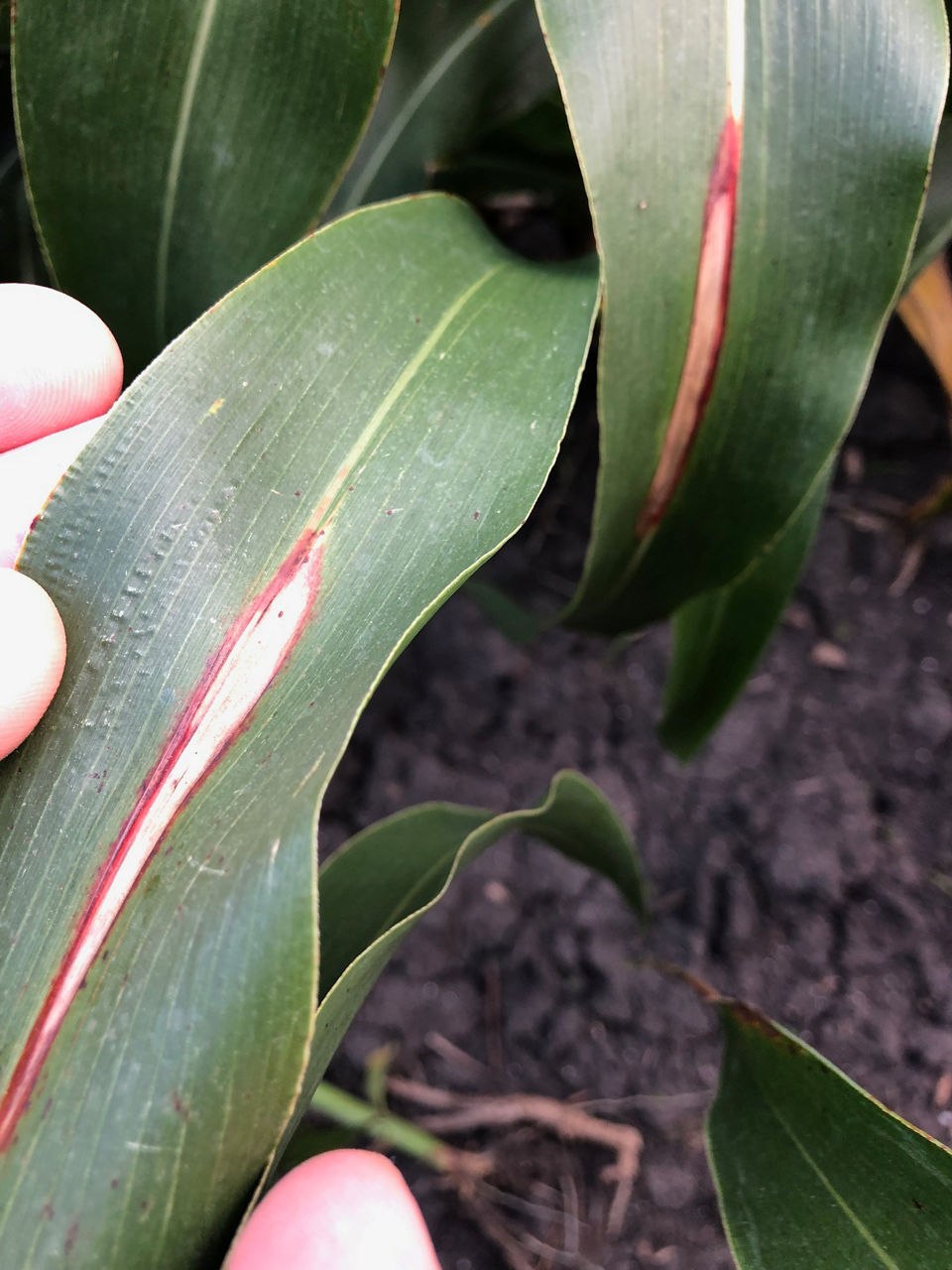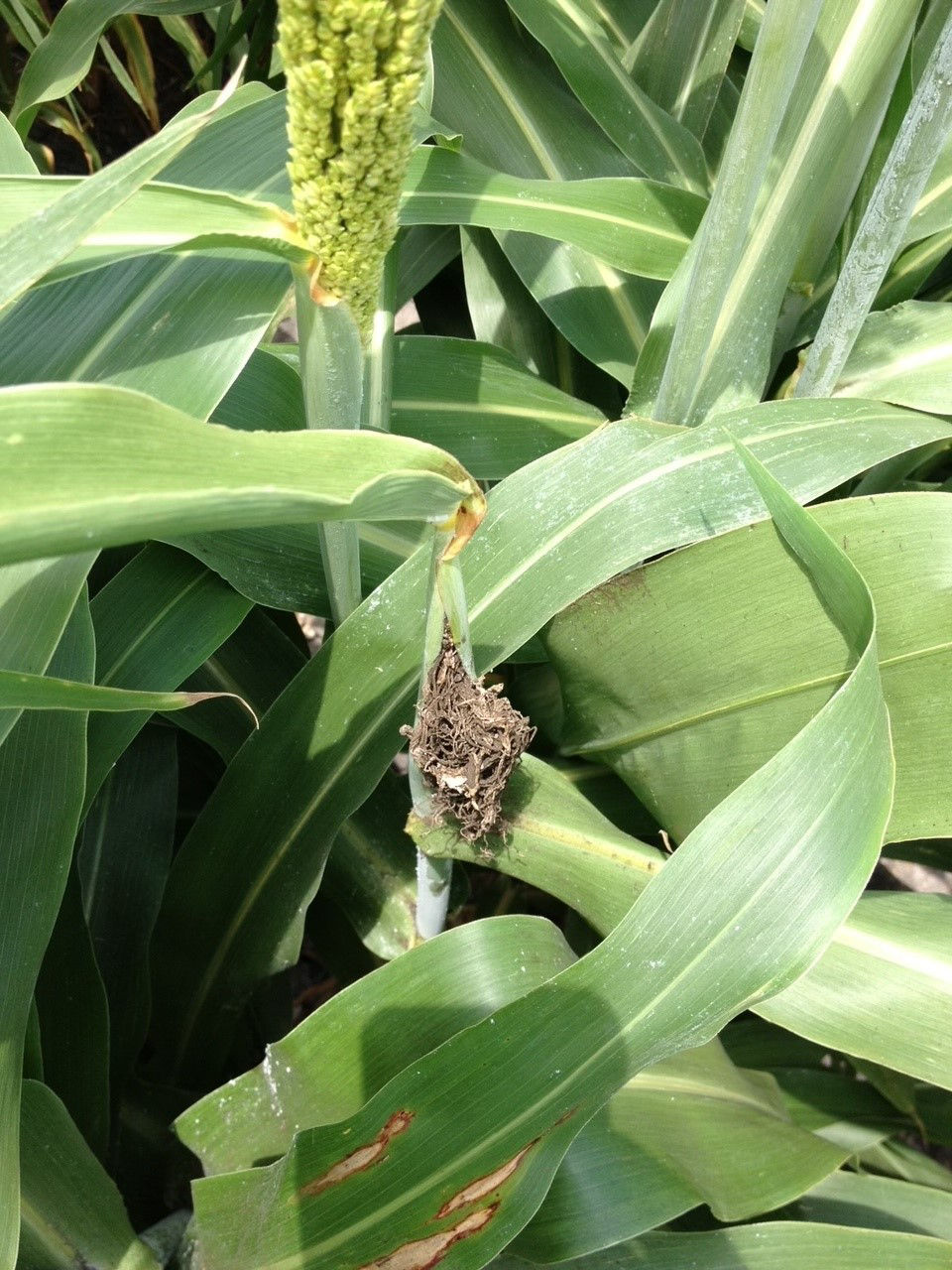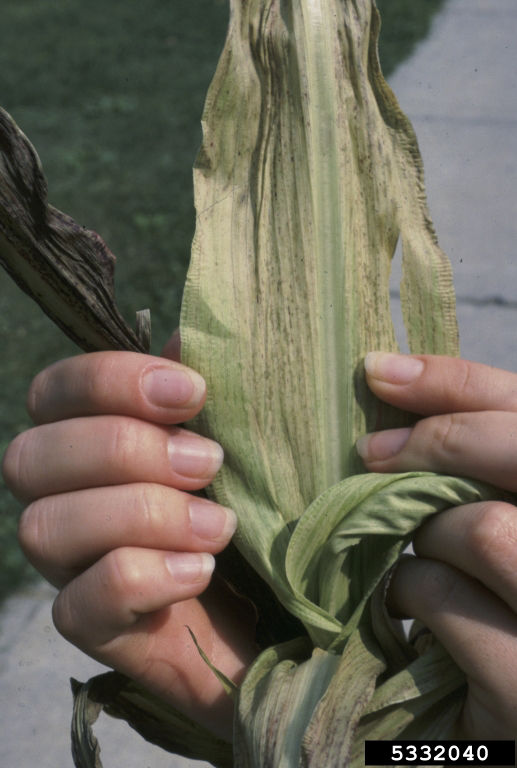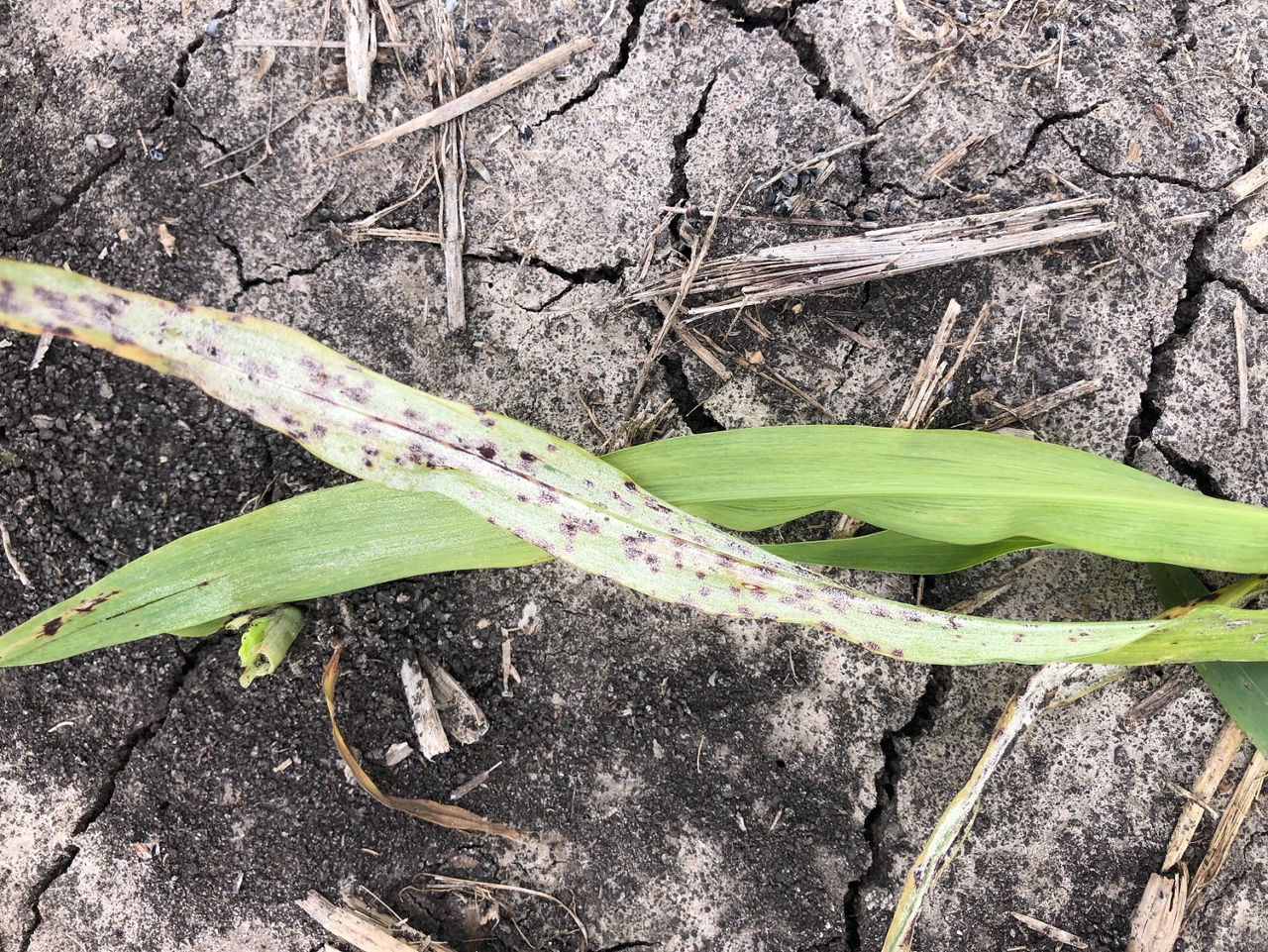Grain Sorghum Diseases: Identification and Management
September 5, 2024
- Planting grain sorghum (milo) in unfavorable growing conditions can result in a number of diseases, which may reduce both seed quality and yield potential.
- Losses from diseases can be minimized by optimizing manageable growing conditions, rotating with other crops, and removing disease-infested residue.
- Effective control measures can be implemented after diseases are accurately identified.
- The severity of any infection depends on environmental conditions, the presence and population levels of pathogens, and the host plant’s resistance.
Potential yield losses from diseases may be minimized or reduced by adopting integrated pest management tactics such as:
- Using seeds treated with fungicide to prevent seed rots and seedling blights.
- Using tolerant/resistant grain sorghum products.
- Rotating to a non-susceptible crop.
- Removing infested crop residue.
- Managing growing conditions throughout the growing season.
Although grain sorghum can be infected by several diseases, the diseases below have the highest probability of negatively impacting yield potential.
Crazy Top Downy Mildew
Crazy top downy mildew is a disease caused by the fungus Sclerophthora macrospora. The disease is most likely to occur in field low spots where water stands. High soil moisture levels and flooding are favorable conditions for the disease to develop. Infected plants have thick, stiff, twisted, pale green leaves with bumpy surfaces. The leaves often turn downward, and the plants produce many shoots or suckers, giving the plant a bunchy or broom appearance. Infected plants produce a proliferation of leafy tissue instead of heads.
Management
- Improve drainage in problem fields.
- Plant tolerant sorghum products. Although there are differences in susceptibility among grain sorghum products, these differences are not substantial.
Anthracnose
Anthracnose is caused by Colletotrichum graminicola, and can injure leaves, panicles, and stems. Infected stems, cut lengthwise, may show brick-red sections surrounding areas of the infected pith tissues, which may appear healthy and white in color (Figure 1). Anthracnose development is weather dependent and has been mostly restricted to humid regions. Severe anthracnose infection can greatly reduce yield potential.

Management
- Sorghum products rated as “susceptible” should be avoided in fields with a history of anthracnose.
- Rotating to a crop that is unrelated to grain sorghum is highly recommended. Cotton should be planted for at least two years before planting grain sorghum after an anthracnose infection. Note that this practice does not eliminate the potential for infection but can reduce disease severity.
- Good residue management should be practiced.
Foliage Diseases
Several fungal organisms can infect the foliage, including sorghum ergot, northern corn leaf blight, sooty stripe, and rust. Infection may become severe under periods of extended humid conditions. In most years, foliar disease development occurs from the whorl through maturity. Foliage diseases are rarely a problem if sorghum is to be harvested for silage, as they generally appear at later stages of plant growth. Yield reduction is seldom large enough to warrant specific control practices, though yield loss can occur if injury occurs to the upper leaves at the grain filling stage. Sorghum products vary in their susceptibility to these diseases.1
Sorghum Blight
Leaf blight is caused by Exserohilum turcicum. The symptoms are elongated, elliptical lesions with reddish margins and tan centers (Figure 2). The disease is more common in humid production areas and infection is more common under moderate temperatures. Excess moisture from dew, irrigation, or rainfall promotes infection. Yield losses are greatest if the infection occurs prior to the boot stage.
Management
- Rotate to non-susceptible crops.
- Use foliar applications of labeled fungicides.
- Plant resistant products.

Head Smut
Head smut is a disease caused by Sphacelotheca reiliana. Soilborne smut spores from previous crops can infect young sorghum seedlings, which may remain relatively healthy in appearance. At heading, a large mass of dark-brown smut spores appears in place of the panicle (Figure 3).

Management
- Avoid planting head smut-susceptible products in the same field for several years, as doing so can rapidly increase the percentage of infected plants.
- Products with compact heads and fungicide seed treatments should be used in fields with a history of the disease.
- In some cases, promptly removing and burning head smut may prevent the spread of smut spores.2
Maize Dwarf Mosaic Virus (MDMV)
Maize dwarf mosaic virus (MDMV) causes a distinctive leaf mottling (light-green blotchiness), plant stunting, and reduced yield potential. Another distinct symptom is often called “red leaf”, which appears as a reddish discoloration and tissue death on leaves, sheaths, and peduncles (Figure 4). Johnsongrass serves as the overwintering host and source of the virus by maintaining the virus in underground rhizomes until it moves into the young Johnsongrass shoots in the spring. Aphids, feeding on the infected Johnsongrass, acquire the virus and move it to other non-infected Johnsongrass plants and/or to young grain sorghum plants.
Management
- Most grain sorghum products are susceptible to MDMV; however, some products may show less severe symptoms and little to no yield loss.
- “Susceptible” or “very susceptible” sorghum products should not be planted in fields where Johnsongrass is prevalent.
- Control Johnsongrass in sorghum fields and in areas adjacent to the fields.3

Sorghum Downy Mildew (SDM)
Sorghum downy mildew (SDM) is caused by Peronosclerospora sorghi. Outbreaks of SDM have been associated with metalaxyl-resistant strains of the fungus and the use of susceptible sorghum products. Systemically infected seedlings are pale yellow or have light-colored striping or mottling on the leaves. Infected plants can be stunted and may die prematurely. The fungus may produce a downy black growth on the underside of leaves (Figure 5).4
Management
- Use a three-pronged management approach of crop rotation, sorghum product selection, and fungicide treated seed.
- Fields in which SDM is prevalent should be rotated out of sorghum production for at least two years to reduce levels of soilborne inoculum.
- Cotton, wheat, soybean, or a forage crop should be rotated with grain sorghum.

Summary
Grain sorghum diseases are difficult to control after they develop, thus an integrated management approach should be adopted to help minimize potential yield losses. Planting high quality seed that has been treated with fungicide, using resistant/tolerant products, rotating with other crops, eliminating susceptible weed hosts such as Johnsongrass, providing optimum growing conditions, and avoiding planting into poorly drained fields are some of the practices recommended to minimize potential yield losses.2,3,5
Sources
1Krausz, J.P., Collins, S.D., Frederiksen, R.A, Duncan, R.R., Kaufman, H.W., and Odvody, G.N. 2011. Disease response of grain sorghum hybrids. The Texas A&M University System. http://lubbock.tamu.edu/files/2011/10/b6004.pdf
2Vincelli, P. and Hershman, D.E. 1993. Kentucky plant disease management guide for corn and sorghum. University of Kentucky, Agriculture and Natural Resources Publications. 64: PPA-10a. https://uknowledge.uky.edu/anr_reports/64/
3Bissonnette, K., Wrather, A., and Sweets, L. 2022. Management of grain sorghum diseases in Missouri. University of Missouri Extension, Agricultural MU Guide. G4356. https://extension.missouri.edu/publications/g4356
4Isakeit, T. 2015. Scouting for sorghum downy mildew. The Texas A&M University System. https://agrilife.org/texasrowcrops/2015/05/04/scouting-for-sorghum-downy-mildew/
5Vanderlip, R., Roozeboom, K., Fjell, D. et al. 1998. Grain sorghum handbook. Kansas State University Agricultural Experiment Station and Cooperative Extension Service. C-687. https://bookstore.ksre.ksu.edu/pubs/grain-sorghum-production-handbook_C687.pdf
Web sources verified 06/10/24. 2111_412538
Seed Brands & Traits
Crop Protection
Disclaimer
Always read and follow pesticide label directions, insect resistance management requirements (where applicable), and grain marketing and all other stewardship practices.
©2024 Bayer Group. All rights reserved.